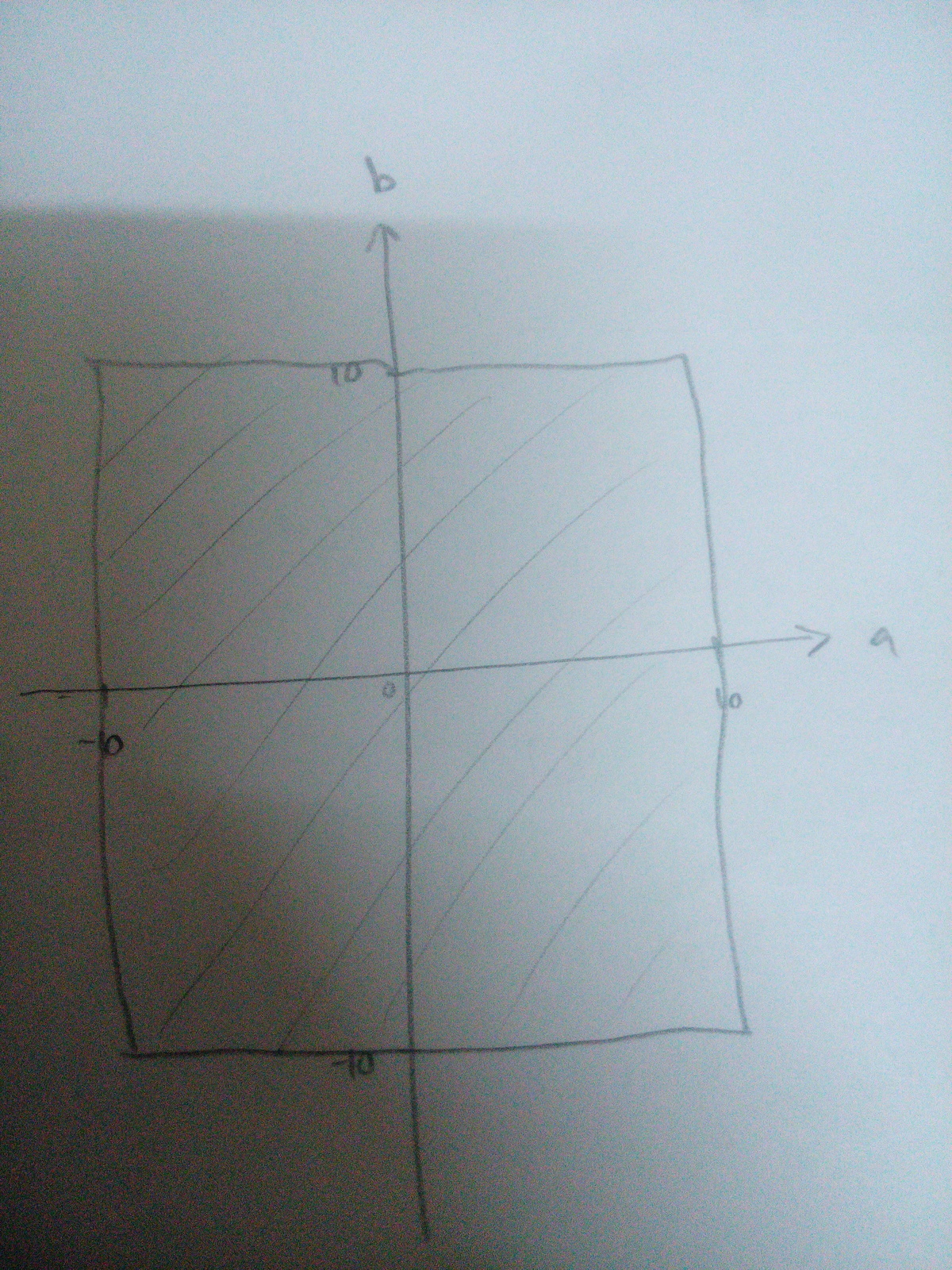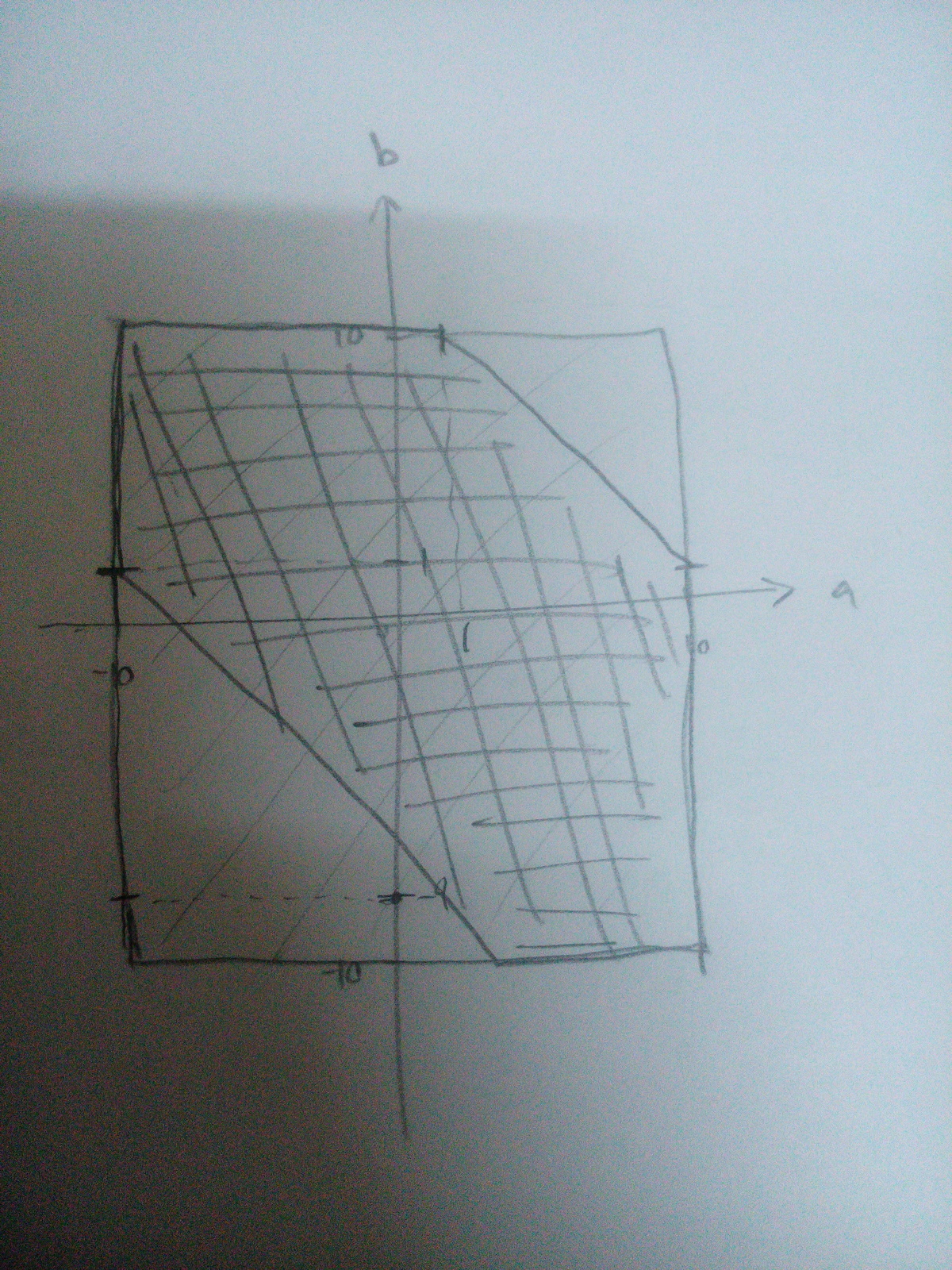Addition Distributes over Multiplication?
We know that by the distributive property a ( b + c ) = a b + a c is an identity. However, a + b c = ( a + b ) ( a + c ) is not an identity.
Find the number of ordered triples of integers ( a , b , c ) in the interval [ − 1 0 , 1 0 ] such that a + b c = ( a + b ) ( a + c ) .
The answer is 751.
This section requires Javascript.
You are seeing this because something didn't load right. We suggest you, (a) try
refreshing the page, (b) enabling javascript if it is disabled on your browser and,
finally, (c)
loading the
non-javascript version of this page
. We're sorry about the hassle.
3 solutions
Sir, I am getting the answer as 761;
441 cases when a=0; 21 cases when a=1; 20 cases when a=2; 19 for a=3 and so on till 12 for a=10;
Similarly I get 20 cases for a=(-1); 19 cases for a=(-2) and so on till 11 cases for a=(-10) and then
441+ 21 + 2(20+19+18......+12) +11 = 761 ; so which 10 cases am I overcounting?
Log in to reply
Check your a is negative case again. You can match your numbers up against mine see that the a < 0 count is off.
Rearrange the equation we get a = a ( a + b + c ) . With a = 0 , the equation becomes a + b + c = 1 , where a , b , c ∈ [ − 1 0 , 1 0 ] . Now, we will ignore the fact that a = 0 and eliminate that case later.
Interesting things happen now, move c to RHS to form a + b = 1 − c . Then this is the space for all combination a , b within their domain.

Their sum must be within 1 − c ∈ [ − 9 , 1 1 ] , which is

The problem becomes finding the number of lattice points within the polygon. We will do this by applying Pick's Theorem.
Area = 2 0 × 2 0 − 2 1 × 1 1 × 1 1 − 2 1 × 9 × 9
B = 3 × 9 + 3 × 1 1
By Pick's Theorem,
Area = I + 2 B − 1
which gives us I = 2 7 0 , so the number of lattice points within the polygon is I + B = 3 3 0 .
Recall that in this case, we considered a = 0 , but we need not have b + c = 1 . So we will remove the case b + c = 1 and add all their combinations. The number of cases where b + c = 1 is 2 0 and their total combinations is 2 1 × 2 1 = 4 4 1 . Hence, the answer is 3 3 0 − 2 0 + 4 4 1 = 7 5 1 .
Here's a generating functions solution.
Note that a + b c = ( a + b ) ( a + c ) ⟺ a = a 2 + a ( b + c )
Case 1: a = 0
In this case, b and c can take any value. So, this case gives rise to 2 1 × 2 1 = 4 4 1 solutions.
Case 2: a = 0
The condition now reduces to a + b + c = 1
In this case, the number of solutions is equal to the coefficient of x in the following expression :
( − 1 + A ) A 2 where A = r = − 1 0 ∑ 1 0 x r = x 1 0 1 1 − x 1 − x 2 1
where the gp summation formula is used to get the last form of A .
So, the expression now becomes x 3 0 1 ( 1 − x ) 3 1 ( 1 − x 2 1 ) 2 ( 1 − x 2 1 − x 1 0 ( 1 − x ) ) ( ∗ )
Now, Newton's binomial theorem shows that ( 1 − x ) 3 1 = r = 0 ∑ ∞ ( 2 r + 2 ) x r
Simplifying the numerator of (*), we get the following :
x 3 0 1 ( r = 0 ∑ ∞ ( 2 r + 2 ) x r ) ( 1 − x 1 0 + x 1 1 − 3 x 2 1 + 2 x 3 1 + x 3 2 ( some more terms ) )
Hence, the coefficient of x in the expression is ( 2 3 3 ) + ( 2 2 2 ) − ( 2 2 3 ) − 3 ( 2 1 2 ) + 2 ( 2 2 ) = 3 1 0
And so, total number of solutions is 4 4 1 + 3 1 0 = 7 5 1
Why did you select the generating function as ( − 1 + A ) A 2 and not A 3
Log in to reply
Coz a = 0
Log in to reply
Oh yeah I did not remember to exclude the first case that has already been considered.
a ( b + c ) = a b + a c ⇔ a ( a + b + c − 1 ) = 0
Let's consider the following cases:
Case 1. a = 0 .
Then b , c can be any value, so there are 2 1 × 2 1 = 4 4 1 possibilties.
Case 2. a > 0 .
We must have a + b + c = 1 .
Use the change of variables x → a , y → b + 1 1 , z → c + 1 1 . Then we are looking for positive integer solutions to
x + y + z = a + ( b + 1 1 ) + ( c + 1 1 ) = 2 3 , 1 ≤ x ≤ 1 0 , 1 ≤ y ≤ 2 1 , 1 ≤ z ≤ 2 1
We apply PIE to the restrictions of x ≥ 1 1 , y ≥ 2 2 , z ≥ 2 2 . We are looking for the number of solutions that satisfy none of these conditions.
If there are no restrictions, then there are ( 2 2 2 ) = 2 3 1 .
If we have the single restriction x ≥ 1 1 , then using the change of variables X → x − 1 0 , we are looking for positive integer solutions to X + y + z = 1 3 , of which there are ( 2 1 2 ) = 6 6 solutions.
If we have the single restriction that y ≥ 2 2 , then using the change of variables Y → y − 2 1 , we are looking for positive integer solutions to x + Y + z = 2 , of which there are ( 2 1 ) = 0 solutions.
Similarly, if we have the single restriction that z ≥ 2 2 , then there are ( 2 1 ) = 0 solutions.
If we have any pair of restrictions, clearly there are no solutions.
If we have all 3 restrictions, clearly there are no solutions.
Hence, in this case, there are 2 3 1 − ( 6 6 + 0 + 0 ) + ( 0 + 0 + 0 ) − 0 = 1 6 5 solutions.
Case 3. a < 0 . We must have a + b + c = 1 .
Use the change of variables x → − a , y → − b + 1 1 , z → − c + 1 1 . Then, we are looking for positive itneger solutions to
x + y + z = − a + ( − b + 1 1 ) + ( − c + 1 1 ) = 2 1 , 1 ≤ y ≤ 2 1 , 1 ≤ z ≤ 2 1
We apply PIE to the restrictions of x ≥ 1 1 , y ≥ 2 2 , z ≥ 2 2 . We are looking for the number of solutions that satisfy none of these conditions.
If there are no restrictions, then there are ( 2 2 0 ) = 1 9 0 .
If we have the single restriction x ≥ 1 1 , then using the change of variables X → x − 1 0 , we are looking for positive integer solutions to X + y + z = 1 1 , of which there are ( 2 1 0 ) = 5 5 solutions.
If we have the single restriction that y ≥ 2 2 , then using the change of variables Y → y − 2 1 , we are looking for positive integer solutions to x + Y + z = 0 , of which there are 0 solutions in positive integers. Similarly, if we have the single restriction that z ≥ 2 2 , then there are 0 solutions in positive integers.
If we have any pair of restrictions, clearly there are no solutions.
If we have all 3 restrictions, clearly there are no solutions.
Hence, in this case, there are 1 9 0 − ( 5 5 + 0 + 0 ) + ( 0 + 0 + 0 ) − 0 = 1 3 5 solutions.
Thus, there are a total of 4 4 1 + 1 6 5 + 1 3 5 = 7 5 1 solutions.